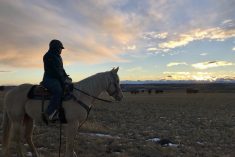Although we always have numerous things to evaluate on our cow selection, the importance of udder and teat conformation should not be underestimated. Many a cow is culled later in life because of bad teats. Her calves may have a hard time sucking and getting that much-needed colostrum. Getting a calf sucking on the big Coke bottle teats can take a lot of individual attention in the spring calving rush when labour is at a premium.
When making your heifer replacement selection in the spring be cognizant of the need to look at the developing udder for signs of abnormally large or small teats. You want the teats placed uniformly in a square. You don’t want extra teats. This is of course especially critical in dairy cattle where milkers are put on four teats on a twice-daily basis. Most supernummery (extra) teats are rudimentary at best and are usually either between the normal teats or behind the normal four teats. We do surgically remove a few in show cattle but most often they are left. Where they become a problem is if they are large the calf may try to suck on them. They are most often blind ending and rudimentary so don’t have the milk-producing gland attached to them. The problem is calves can spend a lot of time when born trying to get milk out of them. Occasionally you will have a five-quartered cow, which doesn’t hurt in a beef herd but is a definite no-no in a dairy animal. For that reason most dairies check newborn calves and remove the extra teats then.
Read Also

Reintroducing fire to Saskatchewan pastures
Pastures evolve over time. Woody plants and shrubs, which cattle can’t eat, may encroach on natural grasses. Invasive species, such…
Some heifer calves deposit a lot of fat in the udder. This extra fat has been proven to definitely hurt her future milk production. They become the good-looking fat healthy cows that produce the scrawny calves because of lack of milk production. Lower weaning weights are most generally a sign of poor milk production by the mother unless there was another medical reason for the poor weight gains. This is another good reason for records and having tags in both cow and calf. By knowing the birth date of the calf and its size at weaning the poor milkers can be eliminated.
Teats on yearlings should be noticeable but not too large and evenly placed. Too small or too large make it difficult for the calf to latch onto at birth. Smaller teats also have a smaller streak canal requiring lots of sucking to get any amount of milk. Calves are not stupid so will gravitate to sucking on the teats that milk the easiest. Too-large teats are hard for the calf to suck on as well. They have larger streak canals and if the teat sphincter is not tight will often leak milk if not sucked out. These quarters, because of the leaking milk and not being sucked out, are subsequently prone to mastitis. Over the years the teat will get larger and larger from never being milked out or a chronic mastitis will take hold rendering the quarter useless.
The good news about chronic mastitis is the quarter can if the cow is not sick be dried off chemically. Your veterinarian can advise on treatment and usually it would involve either copper sulphate solution or silver nitrate solution put up the infected quarter. This sets up a chemical inflammation scarring and drying off of the quarter. I would use 12 cc of a 1 per cent silver nitrate solution infused up the quarter and then repeat in 10 days. It is much easier if the cow is in the process of being weaned and the other quarters are being dried off naturally. The cow then freshens next year as a three teater. Overall milk production does not suffer as a three-teated cow will have some compensation and produce almost as much as a four-teated cow. If two quarters are shot it is best to cull as milk production is considerably less. The taste of mastitic milk is not good so calves usually avoid these quarters and the swelling and inflammation should alert the producer to check.
Scarred teats, blind teats are more difficult to pick up but telltale signs are the calf always seems to be sucking and yet is gaunt or the cow’s udder is always full. If in doubt get her into the maternity pen and strip out the quarters to see if milk is present. With easy calving, not many cows are brought into a maternity pen to calve them out but if they are strip them out to make sure teats are not plugged. This makes it much easier on a calf just getting started and you will detect problems early. Many a calf starves to death each year or doesn’t get enough colostrum because of teat issues.
Heavy milkers in later life develop low slung bags and/or their suspensory apparatus becomes stretched. This puts teat placement too low making it difficult for tall calves to suck. They should be put on the cull list. Self suckers or heifers which suck on their pen mates should also be sold as slaughter animals. Watch also for teat injuries from freezing on windy cold days. Ointments may be able to save you some serious mastitis problems or calves getting kicked from sucking these sore blackened teats.
By being diligent in checking teat and udder conformation early and not using the undesirables as replacements we can lower the cull rate for udder and teat problems later in life. You won’t eliminate all the problems but most can be avoided. Your goal is tight uddered, soft milkers with good milk production having a long productive life in your herd.















